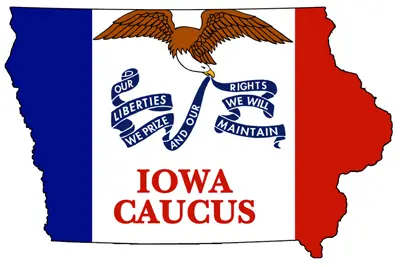The Iowa Caucuses will be held on February 1, 2016. The caucuses are an event where voters from all of 1,774 Iowa voting precincts meet to elect delegates to the county conventions. From the county convention, of which there are exactly 99, delegates are chosen for the state party convention. Eventually, the state party convention elects delegates to attend the national party convention, where a Presidential nominee is selected. The process is similar for both Democrat and Republican candidates. The winner of the Iowa caucus receives the most delegates elected to the county convention, which then elects delegates for that candidate to the state convention, and eventually, to the national convention.
Caucus Date:
Monday, February 1
Results: 2016 Iowa Caucus Results
Find Your Caucus Location:
Democratic Caucus Locations
Republican Caucus Locations
Delegates:
52 Democratic
30 Republican
Type: Closed – Voters may only participate in the caucus of the party they are registered for.
Latest Polls: Democrats, Republicans
Iowa Political Parties: Republican Party of Iowa, Iowa Democratic Party
Historical Winners: (by year)
2012: Rick Santorum (R)
2008: Barack Obama (D), Mike Huckabee (R)
2004: John Kerry (D)
2000: Al Gore (D), George W. Bush (R)
1996: Bob Dole (R)
How Do The Iowa Caucuses Work?
The caucuses do not work the same as a typical primary. For example, the caucuses are usually held in homes or smaller venues, where voters discuss the candidates, then make their choice. The results are tallied and sent into party headquarters. Iowans, some many political observers, actively defend the caucus as a shining example of grassroots democracy, others charge that caucuses are archaic, arcane, and unrepresentative.
Party chairs in the ninety-nine Iowa counties are explicitly charged with issuing the “call” to caucus, setting up caucus locations, and identifying temporary chairs for each of their caucuses. Unlike a primary election, the costs of the precinct caucuses are borne by the parties, not the state. One result is that one of the first activities of any precinct caucus is to “pass the hat” to raise funds for the county and state party. But also unlike a primary election, vote counting is done by the parties, not government officials.
The caucus model is though to give more power to the grassroots activists as it requires more involvement than simply visiting a regular polling location, and casting a vote. The presidential-year caucus date has been the same for both parties since the agreement in 1976, and the parties start their precinct caucuses at about the same time, often in the same building. Voters sign in on pre-printed forms listing all registered party members in their precinct. Those who are not registered with the party may register at the door, so caucus participants need not be registered voters ahead of time. This is different from primary elections in most states, with the exception of those few that allow election day registration. But no one is allowed to participate without becoming a registered party member.
Republican Caucus Procedure:
The Republicans begin the presidential straw poll. In most precincts this will be carried out via a paper ballot (the state party’s preference), which may be simply torn pieces of paper or a more formal ballot prepared ahead of time by the temporary chair. Those in attendance are asked if anyone wishes to speak on behalf of a candidate. Speeches are usually short, and are of the type “why I support candidate B and why you should too.” Following the speeches, ballots are cast and then collected by the chair, who next assigns someone (perhaps the secretary) to count them, report the results to the caucus, and record them on a form provided by the state party. More information is available from the Republican Party of Iowa.
Democrat Caucus Procedure:
The Democratic presidential preference rules are far more complex. This complexity comes because national party rules require proportional allocation of delegates at every level of a caucus-to-convention nomination system. The viability threshold requirement adds to this complexity, but the system may well end up giving more candidates a chance and more voters a choice, and bring about more sincere voting. Party rules require that “preference groups” not be formed until half an hour after the caucus opens, so the time is usually filled by reading letters of greetings from elected officials, and passing the hat to raise money for the local and state parties. Once the appointed time arrives, things shift into gear. More information is available from the Iowa Democratic Party.
